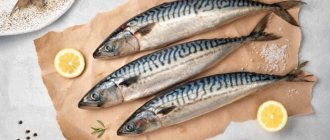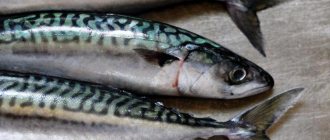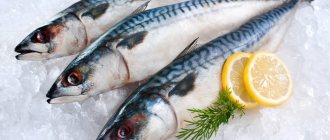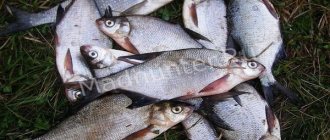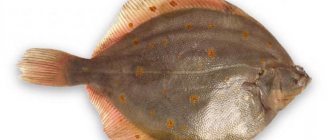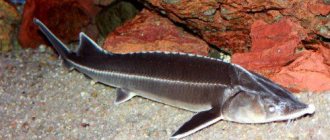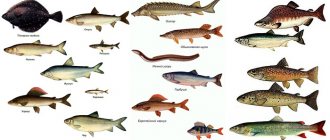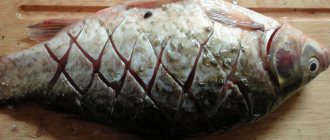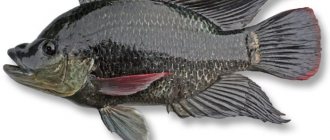Description of the fish
This species is also called king mackerel. Mackerels are fish from the order Perciformes and belong to the mackerel family.
They are distributed in the same area where mackerel is found. Mackerel can be found both in the Arctic Ocean and in areas of other oceans with cold currents.
Fish are epipelagic, i.e. those that live in coastal waters. They are found near rocky shores, near reefs, in estuaries and harbors. Adults can go deep into the ocean, but young ones always swim close to the shore.
The mackerel has a long, elongated body with a sharp head. It is covered with small scales - the so-called vestigial ones, which look like a shiny film. There are many sharp teeth in the mouth.
The back is painted blue with a steel tint, the sides and belly are yellow-silver. Different species have stripes or spots on their bodies. The size of individual varieties varies greatly - from 0.6 to 4.5 m.
Almost all species of mackerel do not have a swim bladder. It is present only in Chinese mackerel.
Fish of the mackerel family prefer to form schools. These are predators that feed on sardines, anchovies, squid and shrimp.

At the same time, mackerel often become prey themselves. Don't mind snacking on them:
- pelicans;
- big tuna;
- sharks;
- sea lions;
- dolphins.
But the main connoisseur of meat and the natural enemy of mackerel is man.
The average lifespan of a fish is 25 years.
Features of character and lifestyle
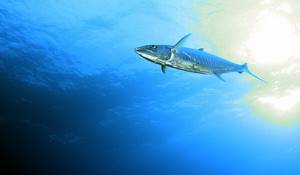
Photo: Blue mackerel
Mackerel are very common fish, found in many parts of the world's largest oceans. They also swim into the seas (including the Black Sea). They are found not only at great depths, but also in close proximity to the shore. This is used by many fishermen who catch prey with a fishing rod. All representatives of mackerel belong to the migratory type of fish. They prefer to live in warm waters (from 8 to 20 degrees). In this regard, there is a constant need to change place of residence.
This does not apply only to individuals living in the waters of the Indian Ocean. The water temperature here is suitable for year-round living. Atlantic mackerel move to the Black Sea for the winter, as well as to the waters of the European coast. At the same time, mackerels practically do not stay on the Turkish coast for the winter. During wintering, the fish are very passive and display a feeding nature. They practically do not feed and stay mainly on the slopes of continental shelves. They begin to return to their “native lands” with the arrival of spring.
During the warm months, members of the class Scomberomorus are very active. They don't sit at the bottom. Mackerel are excellent swimmers and feel confident in the aquatic environment. Their main feature in movement is deft maneuvering and avoidance of whirlpools. The calm speed of fish is 20-30 kilometers per hour. Moreover, when catching prey, the fish can reach up to 80 kilometers per hour in just 2 seconds (when making a throw). This may be due to the presence of a large number of fins of various sizes.
Fast movement speed is achieved due to the absence of a swim bladder and the special spindle-shaped structure of the body. The fish try to stay in schools. This is due to the large number of predators hunting them. In addition, finishing off prey in a flock is much easier. Mackerels rarely live alone.
How is it different from mackerel?
Inexperienced fish lovers do not know what the difference is between mackerel and mackerel. Because of this, unscrupulous sellers can sell one individual under the guise of another.

But fish have 4 differences:
- Mackerel is larger than mackerel. The size of the first will be at least 60 cm, while the body length of the second is on average 30 cm.
- The belly of most types of mackerel is clean and light. Stripes and spots do not extend from the back to the belly. And the mackerel is colored gray or yellow below, with markings on its belly.
- Mackerel meat is fatty, pinkish-gray in color, while mackerel meat is drier and harder, with a gray tint. When heat treated, the fillet of the last fish becomes lighter.
- The stigma of mackerel is blunter, while that of mackerel is sharp and elongated.
Mackerel fish and blue mackerel: what is the difference between them?
We will not go into biology, since we are considering these two varieties of fish from a culinary perspective. Let’s just say that in terms of its composition of useful microelements, mackerel is in no way inferior to mackerel and is perfect for replenishing the body’s nutrients.
But mackerel did not adopt the taste qualities of mackerel, in particular because of its dryness. If you can safely take mackerel either with or without the head, then cooks categorically do not recommend taking mackerel without a head, since part of the juice thus flows out and evaporates and the fish becomes completely dry.
Varieties
Mackerel is a large genus, including 18 species of fish. But in the food industry, only 3 varieties are most often used: striped, Japanese, Indian royal.
Striped
Striped mackerel or Spanish bonito are found in the Indian and Pacific Oceans in areas with warm, moderate currents. Representatives can be found in the Atlantic Ocean near St. Helena Island.

Fish live at depths of up to 200 m. They reach a length of 2.4 m, and a maximum weight of 70 kg. One of the coveted trophies of fishermen. The white meat of Spanish bonito is prized by chefs. Available fresh, frozen, smoked or salted.
In some regions, fish meat contains a toxin similar to poison.
Heavy fishing of striped mackerel has reduced the fish population. She has been classified as Near Vulnerable.
Japanese
Japanese king, small-spotted mackerel or sawara is a fish with a long and elongated body. Weight no more than 5 kg with a size of 1 m.
Savara is found off the coast of China, Taiwan, Korea - south of the island of Hokkaido. In Russia, they are occasionally found in Peter the Great Bay.
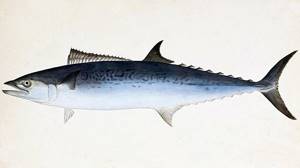
Savara lives shorter than other species - about 6 years, while other varieties reach an age of 20-25 years.
The Japanese value sawara meat. They use it to prepare their national dish, sashimi (sliced raw fish fillets with wasabi and soy sauce). Therefore, carcasses arrive at local markets freshly slaughtered or alive. When imported into other countries, they are frozen.
Japanese mackerel are caught en masse in winter, when the meat is the fattest and most valuable. They use seines and nets.
Royal
Indian king mackerel or spotted bonito has the most valuable meat. Despite the loud name, the size of the fish is small - 60 cm. The largest representatives reached 76 cm in length.
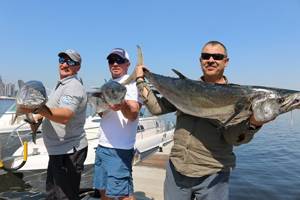
But the taste of the fish is amazing. Every fisherman living in India, Thailand, Indonesia, Malaysia, Kampuchea wants to get it - where mackerel is found, or rather, a representative of the mackerel family.
The population has declined in the last couple of decades. Therefore, the fish were taken under protection. Poaching and mass trapping are prohibited.
Origin of the species and description
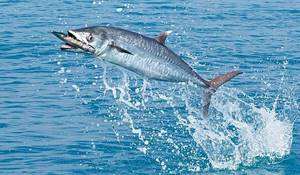
Photo: Mackerel
Mackerel (Scomberomorus) is a representative of the mackerel class. This group includes more than 50 species of fish. Among them are world-famous tuna, mackerel, and mackerel. All fish are included in the ray-finned class. Its representatives are found all over the world, and the group itself is considered the most numerous in terms of generic and species composition.
Video: Mackerel
The following species of mackerel belong to the specific genus Scomberomorus:
- Australian (broadband). Found in places where rivers flow into the sea. The main habitat is the waters of the Indian Ocean;
- Quinndsleigh. Habitat: tropical waters of the Indian Ocean and the central and southwestern parts of the Pacific Ocean;
- Malagasy (multi-band). Inhabits the southeastern waters of the Atlantic, as well as the western waters of the Indian Ocean;
- Japanese (small-spotted). This fish lives mainly in the northwestern regions of the Pacific Ocean;
- Australian (spotted). Found in the eastern waters of the Indian Ocean, as well as the western parts of the Pacific Ocean;
- Papuan. Lives in the central-western waters of the Pacific Ocean;
- Spanish (spotted). Found in the Atlantic Ocean (northwestern and central-western parts);
- Korean. Found in the Indian and Pacific (its northwestern waters) oceans;
- longitudinally striped. Inhabits the Indian Ocean, as well as the central-western waters of the Pacific;
- spotted bonito. Habitat: northwestern waters of the Pacific Ocean, Indian Ocean;
- single color (California). Found only in the central-eastern waters of the Pacific Ocean;
- striped royal. Habitat: Western waters of the Pacific, as well as tropical parts of the Indian Oceans;
- royal. Found in the waters of the Atlantic Ocean;
- Brazilian. It is also found in the Atlantic Ocean.
Fish differ not only in their habitat (ocean), but also in their depth. For example, the maximum depth at which Spanish mackerel is found does not exceed 35-40 meters. At the same time, Malagay individuals are found at a distance of 200 meters from the surface of the water. Externally, all mackerels are similar to each other. Minor differences in size are associated with habitat.
Fishing Features
Mackerel is a valuable animal in the fishing industry. It is caught en masse using seines, longlines and gill nets.
Due to overfishing, some fish species are on the verge of extinction.
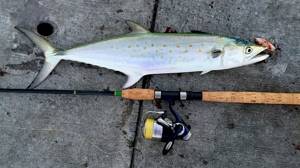
Amateur fishermen are also not averse to catching a fish or two for dinner.
The population has declined in the last couple of decades. Therefore, the fish were taken under protection. Poaching and mass trapping are prohibited.
It is better to fish from a boat or yacht. Use a match rod, float rod or spinning rod. Suitable for bait:
- tyrant - hooks decorated with bright objects: foil, multi-colored feathers, etc.;
- artificial baits, which are sold in fishing stores;
- small freshly caught fish up to 30 cm in size;
- shellfish;
- any fish cut.
Commercial and recreational fishing
Fish is a very valuable and nutritious food product . Therefore, commercial mackerel fishing continues to be a relevant and necessary activity.
In the Russian Federation, fishing takes place in the southern part of the Norwegian Sea. In a year it is possible to catch about 50 thousand tons of this valuable fish. Fishing takes place using special nets and seines. In the past, mackerel was also found in the Black Sea, but, unfortunately, disappeared about 35 years ago.
The mackerel's habitat is coastal waters, so there is no need to swim to the open ocean to catch fish. It can easily be caught with a fishing rod and spinning rod directly from the shore or a small boat.
You can fish from early spring until the coldest weather. For those who like fishing from the shore, the most favorable period will be the spring. Hungry fish swim closest to the shore, where more food can be found. No special gear is required for mackerel; a regular float rod is sufficient.
You can use artificial bait; you can easily make it yourself using shiny objects. It bites well on live bait, but cut fish is also suitable. Due to the fact that mackerel usually swim in large schools, it is easy to catch a lot of this mackerel-like fish in a relatively short time.
Why is mackerel valuable?
At first glance, mackerel meat may seem unappealing. It is a repulsive gray color, not too greasy and hard. However, fish fillet is a storehouse of useful vitamins and minerals.
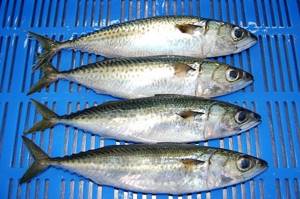
Just 300 g of fish will fill the daily need for phosphorus, and 400 g for potassium.
The most valuable is mackerel caught in northern latitudes in winter. It is fatty and contains a maximum of useful elements.
Regular consumption of mackerel contributes to:
- reducing the risk of developing cancer, diseases of the cardiovascular and respiratory systems, type 2 diabetes;
- preventing arthritis and psoriasis;
- increased life expectancy - thanks to beneficial fatty acids and coenzyme Q10;
- strengthening the walls of blood vessels and preventing thrombosis;
- maintaining healthy joints and bones;
- prevention of anemia and assistance in the fight against anemia due to the high content of vitamin B12 and iron;
- normalization of the thyroid gland - thanks to iodine;
- strengthening potency due to the presence of zinc;
- improvement of skin, hair, nails.
Due to the fluorine and phosphorus content, mackerel fish is a natural prevention of oral diseases. It strengthens the enamel, prevents the development of caries, wedge-shaped defects, pathological abrasion, and strengthens the gums.
Mackerel is good for everyone. It is strongly recommended that elderly people, children, pregnant women, and patients with chronic pathologies use it regularly. However, it should be given to children under 9 years of age with caution due to possible allergies.
Useful properties of mackerel
Composition and presence of nutrients
The composition of mackerel may vary depending on age, location and time of catch. Mackerel caught in winter in northern latitudes is the fattest, and in other cases the fat content can be up to two times less. Mackerel meat is very rich in micro- and macroelements and vitamins.
This fish contains almost all vitamins from group B, including B12, vitamins C, D, PP, slightly less vitamins A, K, H. It also contains macroelements: sulfur, chlorine, phosphorus, potassium, calcium, sodium, magnesium . 300 grams of mackerel contains the daily requirement of phosphorus, and 400 grams will replenish the required daily requirement of potassium.
The set of microelements in this product is no less. Mackerel contains: zinc, iron, iodine, manganese, copper, fluorine, and in small quantities nickel, mobileene, chromium and cobalt.
Medicinal and beneficial properties
Mackerel is very useful, especially if it is caught in the fall. Since it contains more fat and, accordingly, more Omega-3 fatty acids and the most valuable vitamins B12, D. Many studies have repeatedly proven the positive effect of eating fatty fish on the body. Arthritis, heart disease, diabetes, cancer, psoriasis, bronchitis are very often associated with a lack of fish oil in the body. It is known that the Japanese, who eat much more fish products, have a longer life expectancy.
The main beneficial and medicinal properties of mackerel are:
- Preserving youthful arteries. After all, the more amino acids in the cells, the lower the likelihood of blood clots. Fish oil contained in mackerel has an effect similar to aspirin - it thins the blood. Omega-3 acids restore the elasticity of artery walls.
- Slowing down the aging process of the body. Research in the UK has found that frequent consumption of mackerel and other fatty fish has a beneficial effect on the health of both young people and people suffering from heart disease.
- Prevents the development of diabetes. Regular consumption of mackerel reduces the risk of developing type 2 diabetes several times, which was studied by Dutch scientists.
Vitamin B12 is also very important, contained in mackerel. It is very good for health because it takes part in the metabolism and breakdown of fats, in their proper absorption, as well as their removal from the body. The presence of this vitamin allows fat to be absorbed into tissues only in the required quantity and not accumulate in them. Vitamin B12 promotes DNA synthesis in cells, and this, in turn, promotes rejuvenation and renewal of the body. During hypoxia, this vitamin is able to increase oxygen consumption by cells.
Phosphorus, contained in large quantities in mackerel, helps build enzymes, which are the most important engines of reactions in cells. Skeletal tissue is also made up of phosphate salts, which is why mackerel is very useful for children, teenagers, and the elderly.
Mackerel is very useful for joint problems. The minerals it is rich in contribute not only to the supply of essential oxygen to cartilage and bone cells, but also to the growth of cartilage tissue.
And the high content of selenium and coenzyme Q-10 in mackerel can slow down aging.
In cooking
Mackerel is prepared in various ways, it is boiled, smoked, fried or even baked over coals. A traditional mackerel dish in Israel is mackerel casserole. In order to prepare it, you need to cut the fillet into small pieces, add a small onion, a teaspoon of salt, ground white pepper, ground cumin, one medium-sized boiled potato and a tablespoon of starch. All ingredients must be mixed using a blender, and then fry in a frying pan over medium heat. Serve the casserole with boiled potatoes or a green salad.
In order to prepare royal mackerel, it is seasoned with salt, chopped garlic, pepper, and olive oil. Then, completely covering the fish with lemon slices, it is grilled in foil. This dish goes best with dry wine.
In cosmetology
Mackerel itself is not used in cosmetology, but regular consumption of it has a positive effect on the health of hair, bones and nails. This is due to the fact that it is very rich in phosphorus and potassium. Phosphorus is not synthesized in the human body and enters it only with food, and not all food products can provide the daily requirement of this macroelement, which does not apply to mackerel.
Is mackerel good for everyone?
Mackerel has many beneficial properties. But, like any product, fish, if consumed excessively or incorrectly, can be harmful.

It is not recommended to eat fish more often than once every 2-3 days. Excessive consumption of fish oil can thin the blood, increase bleeding, or lead to the opening of ulcers and erosions.
Since fish oil acts as a blood thinner, mackerel should be consumed with extreme caution by people taking aspirin and other anticoagulants.
Boiled or baked mackerel is considered the most useful. Nutritionists do not advise frequently consuming fried, salted, smoked, or canned fish. And people with diseases of the gastrointestinal tract, kidneys, liver, heart, obesity should completely forget about these methods of processing the product.
Mackerel and mackerel similarities and differences
In stores, mackerel and mackerel are often found side by side, sometimes even under the same name. Some claim that these fish are one and the same, others say the opposite. Even having entered the word “mackerel” into a Wikipedia search, we read that mackerel is the same as mackerel.
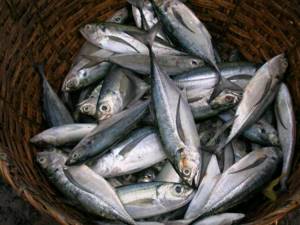
But if you take a serious approach to solving this issue, you can sooner or later stumble upon the conclusion that mackerel and mackerel are fish of two completely different biological genera.
Frequently erroneous trade names have contributed to this confusion.
Since in English these fish are called the same, in stores you can now find both mackerel, called mackerel, and mackerel, which is called mackerel, and it happens that almost all fish of this family are sold under the name “mackerel”.
The word "Mackerel" is a general designation for the entire mackerel family, which includes many fish.
Use in cooking
Mackerel is one of the most valuable fish species in the food industry. It is moderately fatty, tasty, and after heat treatment the meat becomes light and dense.

The variety of dishes with mackerel is off the charts. They eat it:
- raw, flavored with citric acid and seasonings;
- fried;
- boiled;
- baked;
- boiled;
- smoked;
- salty;
- canned.
Fish is best suited for salads. But mackerel fish is better suited for baking and marinating.
General information
Mackerel is a genus of ray-finned marine fish belonging to the Scombridae family. There are 18 species, the most common of which is the striated bonito.
Most mackerels live in the continental waters of the warm seas of the Pacific, Atlantic and Indian oceans, preferring areas near rocky shores and large coral reefs.
Adult large mackerels feed on small fish (anchovies, sardines), various crustaceans (shrimp) and cephalopods (squid). In addition to humans, the natural enemies of mackerel are large tuna, marlin, dolphins, and pelicans.
Reference! Spanish or striped mackerel (another name is striated bonito) is a fish that is often confused with mackerel.
Calories and nutritional value
Due to its fat content, dieters are afraid to eat mackerel. But these fears are in vain. Fish contains healthy fats - Omega-3 acid. In addition, it contains a lot of useful elements that improve metabolism and normalize the functioning of the body.
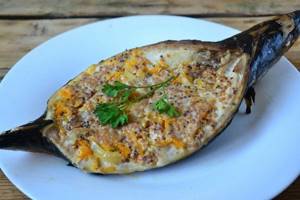
Despite the abundance of fats, fish is low in calories. The number of kcal in different varieties ranges from 110 to 158 per 100 g.
If you cook mackerel using dietary methods (boil, bake, steam), then you don’t have to be afraid of gaining excess weight. Therefore, mackerel is the optimal dish on a diet.
100 g of fish contains 6.3 g of fat, 19.3 g of protein and no carbohydrates. In addition, mackerel is a storehouse of minerals. Detailed contents are given in the table.
| Element | Content mg per 100 g fish |
| Sulfur | 207 |
| Calcium | 50 |
| Sodium | 170 |
| Magnesium | 40 |
| Phosphorus | 240 |
| Chlorine | 165 |
| Potassium | 335 |
| Iodine | 50 |
| Iron | 1,8 |
| Nickel | 6 |
| Fluorine | 430 |
| Zinc | 0,7 |
| Chromium | 55 |
| Molybdenum | 4 |
Average data are indicated, since the nutritional value and amount of macro- and microelements differ depending on the type of fish, its age, and time of catch.
Mackerel also contains many vitamins and microelements:
- group B, especially high in B12;
- a nicotinic acid;
- ascorbic acid;
- retinol;
- calciferol;
- phylloquinone;
- folic acid;
- biotin.
Natural enemies of mackerel
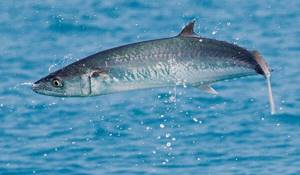
Photo: What mackerel looks like
In their natural environment, mackerels have plenty of enemies. The hunt for fatty fish is carried out by:
- whales are mammals that live exclusively in sea waters. Due to their mass and body structure, cetaceans are able to swallow groups and even schools of mackerel at once. Despite their ability to move quickly, mackerel representatives rarely manage to hide from whales;
- sharks and dolphins. Oddly enough, not only the most evil representatives of marine fauna hunt mackerel, but also “harmless” dolphins. Both types of fish hunt both in the middle layers of water and on its surface. Pursuant pursuit of schools of mackerel is rare. Dolphins and sharks find themselves in the area of mackerel aggregation by pure chance;
- pelicans and seagulls. Birds manage to dine on mackerel only in one case - when they themselves rise to the surface of the water for lunch. Mackerels jumping out after prey often land in the tenacious paws or beaks of pelicans and gulls flying past;
- sea lions. These mammals are very voracious. They need to catch about 20 kilograms of fish in one fishing trip in order to eat enough. Mackerel moving across the water in schools is the best choice for a good lunch.
In addition, humans are a serious enemy of all mackerel fish. All over the world, individuals of this species are actively caught for their further sale. Fish meat is famous for its beneficial qualities and taste. Fish hunting is carried out from the beginning of spring until the onset of cold weather. Mackerel is caught both with a fishing rod and with a net. The annual catch of mackerel on the European coast is about 55 tons. This type of fish is considered commercial. Mackerel is supplied to stores both ready-made (smoked/salted) and chilled.
How to choose
Mackerel is mainly imported into the CIS countries from abroad. It is difficult to quickly deliver fish and store it. Many sellers resort to tricks to make a frozen carcass appear fresh.
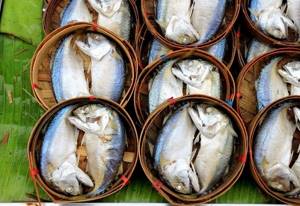
Therefore, when choosing mackerel, you need to pay attention to the following points:
- eyes – clean, not cloudy;
- the smell is characteristic, slightly sweetish, the fragrance indicates stale fish;
- gills - pink, dark, gray or brown indicate stale goods;
- when pressed, the carcass should level out almost instantly;
- the body is shiny, smooth, without traces of blood or dirt;
- dark atypical spots indicate decomposition of the carcass.
It is better not to take frozen fish. Firstly, with repeated cooling and defrosting, it loses its beneficial properties. Secondly, after multiple cold treatments, the fillet becomes an ideal environment for bacteria and microbes.
The closer the fishing point is to the fish market, the better. This way the mackerel will lose a minimum of beneficial properties during transportation.
Eating stale mackerel will lead to intoxication. Unlucky gourmets will develop a fever, vomiting, diarrhea, nausea, dehydration, and headache. In severe cases, Quincke's edema develops, which can lead to death. Death is rare in fish poisoning. However, it is better to buy fresh goods and not risk your health.
Fish selection
When choosing mackerel, you need to pay attention to the transparency of the eyes and the color of the gills. When you press on the carcass with your hand, a dent is formed, which should immediately return to its original position
Fresh mackerel has a sweet and pleasant smell. The appearance should be: moist, shiny, without drops of blood and dryness
When you press on the carcass with your hand, a dent is formed, which should immediately return to its original position. Fresh mackerel has a sweet and pleasant smell. The appearance should be: moist, shiny, without drops of blood and dryness.
You should not catch mackerel in a remote place, because you can get poisoned by stale fish. The bacteria in it can create a poison that can cause nausea, vomiting, thirst, headaches, rashes, itching and more.
Storage rules.
The fish is stored in glass trays with ice, and the trays themselves are covered with a special film. Storing mackerel in the freezer is carried out only after cleaning, drying and washing. Shelf life is three months.
Different cultures.
Each culture has its own differences, even in cooking. In England they like to cook this fish by frying it, the French bake it in foil, and in the east they eat it raw.
Perhaps it would be useful for everyone to know how to properly open and eat oysters.
How to store fish
Gourmets advise eating only fresh mackerel. They insist that when frozen, it loses its beneficial properties, vitamins, minerals and amino acids are destroyed.

But if necessary, you can store the chilled carcass for a couple of days. It is placed in a deep glass bowl, covered with crushed ice and left in the common chamber of the refrigerator.
If there is an urgent need, mackerel is frozen. You first need:
- cut the carcass - remove the entrails, cut off the tail and fins, if desired - remove the backbone and separate the head;
- rinse under running water - cooks advise simply wiping the carcass with paper towels so that the meat does not absorb liquid;
- dry portions;
- place in a container and place in the freezer.
You can store mackerel in the freezer for up to 3 months. However, during cooking, frozen fillets will fall apart.
It is better to remove the entrails from the fish through a cut on the back rather than on the belly. It is in the abdomen that fish oil accumulates. If you make a cut on the belly, the carcass will lose its juiciness.
Getting to know the fish
During fishing tours, you should never neglect catching even small, but quite rare and unique fish. Moreover, fishing in the open ocean can be tiring and instead, you decide to fish calm coastal areas. Mackerel fish can be a good trophy in such places. Its Pacific species, also called Sierra, often becomes our trophy when fishing in Costa Rica. The mackerel's full range extends across the eastern waters of the Pacific Ocean, from the Gulf of California to the coast of Chile, including the Galapagos Islands.
Pacific mackerel (Mackerel, Pacificsierra, Scomberomorussierra) belongs to the large mackerel family. These are relatively small fish, reaching a size of up to 7-8 kilograms. Representatives of this family are equally correctly called mackerel (this comes from English-speaking countries) and mackerel (after the name of the family). It should be understood that Pacific mackerel and mackerel are the same type of fish. Often even more euphonious names are applied to it, such as golden mackerel or king mackerel. But this applies more to the commercial fishing industries.
Appearance
The appearance of the Pacific Sierra mackerel is very different compared to its relatives in the family. The body coloring can be called unique in relation to other mackerels. Mackerel is a fish that is covered with golden spots. It is enough to look at the photos of mackerel to see them and appreciate its originality.
The body has a spindle-shaped oblong shape. Scales are cycloid, small. The back is silvery-blue, and the sides and belly are silvery-white. On the sides, along the body, there are many pronounced yellow-brown dots, which start from the gill covers and continue to the caudal peduncle.
The head of the mackerel is not too large, with pointed, narrow jaws, inside of which there are large teeth. The eyes are large. All fins, including the caudal one, have pointed ends. They are characterized by a black color.
Habitat Features
Sierra mackerel prefers tropical, well-warmed waters. It avoids great depths and most often stays close to the shore. Choosing places not only with warm water, but also places rich in food supply. Due to these factors, mackerel is considered a migratory fish. The search for warmer water places leads to both intensive feeding and the beginning of spawning, which usually takes place in the spring.
Feed objects
Pacific mackerel is a fairly aggressive predator that hunts quickly and aggressively. The food supply for this fish consists of small fish, which are found in abundance along the coastline, as well as small cephalopods. With the greatest pleasure she feeds on herring and anchovies.
Mackerel fishing
Mackerel fishing, which is organized by ROYAL-SAFARI, will rarely be targeted. However, catching this rare and beautiful trophy will be a very good memory in the record of any angler. Fishing for Pacific mackerel can be done both with trolling gear and with spinning gear, using casting casts. Lures are any suitable imitations of the previously mentioned animals that are closely similar in size.
World record according to IGFA: Pacific Sierra mackerel – 8 kilograms.
Below everyone can see a photo of a mackerel fish and appreciate its original appearance.
Cooking methods
The best mackerel for culinary masterpieces is a fresh carcass of about 0.5 kg. This fish is moderately fatty and juicy.
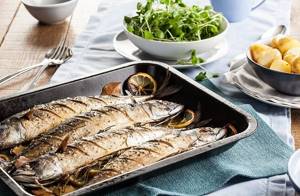
It is better to take the carcass with the head - when it is cut off, some of the juices are lost, and the meat becomes harsh and dry.
If you come across frozen fish, you need to put it in a colander, and place the latter on a pan or bowl so that the water drains into the container. You should not completely defrost the carcass - it should remain slightly frozen, otherwise it will be difficult to cut it.
From the fish that is planned to be stuffed, the ridge is taken out and large bones are removed. They also leave the head to make the dish look presentable.
Mackerel is not common in the CIS countries. Therefore, there are no national dishes. But there are plenty of them in other countries:
- In Latin America they prepare the so-called ceviche. This dish is made from raw fish fillets seasoned with lemon juice, pepper and salt.
- In Japan, mackerel is also eaten raw. In addition to lemon juice, salt and pepper, soy sauce and wasabi are added to it, and fillet pieces are wrapped in seaweed and rice.
- In Italy they cook fish baked in a frying pan. It is skinned, fins, head, tail, and entrails are removed. The processed carcass is placed in a deep frying pan with a thick bottom. Season with lemon juice, black peppercorns, bay leaves, and add unopened caper buds. Fill the mackerel with water so that it is completely immersed in the liquid. Place in the oven and bake for half an hour. The finished fish is placed on a dish, poured with olive oil and served.
- In France, fish are simply fried. The secret of romantics is sauces. Mackerel is served with sauces made from mushrooms, fennel, sorrel, and gooseberries.
- Spain is distinguished by the spiciness of the dish. Here the mackerel is generously flavored with cayenne pepper and mustard. Breaded in breadcrumbs and baked. Served with sherry to soften the spiciness, for which the dish was even nicknamed “devil’s mackerel.”
- In Israel they prepare a fish fillet casserole. In a blender, chop the meat, boiled potatoes, and raw onions into pieces. Add 1 tbsp. l. starch, salt, cumin and white pepper to taste. Mix thoroughly and fry in a frying pan or bake in a glass dish in an electric oven or microwave.
- In England, fish is eaten salted or smoked.
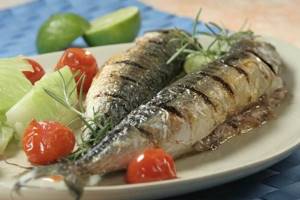
There are many ways to process mackerel. It is boiled or steamed, and then flavored with sour sauce. A good dietary option is to bake a carcass in the oven, chopped with lemon slices, onion rings, garlic cloves or brushed with sour cream.
The fish is also fried in vegetable or butter, stewed in wine or with vegetables, baked on coals or grilled.
Mackerel has recently appeared on domestic shelves. It is healthy and contains many vitamins and minerals. By consuming it regularly, you can avoid diseases of the heart, blood vessels, musculoskeletal system, and hormonal pathologies.
History of mackerel
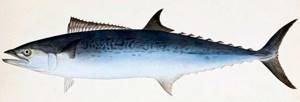
Mackerel was eaten by the ancient Romans. In those days, fish was much more expensive than regular meat. Many tried to breed it in ponds, and the owners of rich estates even equipped piscinas (cages with sea water carried through canals).
Lucius Murena was the first to build a special fish breeding pool. In those days, mackerel was boiled, stewed, baked, grilled, and even fricassee. Garum sauce, which was made from mackerel, was extremely popular.
Description and features
Mackerel is a fish that looks like a spindle: its head and tail are thin and elongated, and its body is as thick as possible, flattened on the sides. It is covered with small scales that resemble leather, which greatly facilitates the preparation process - there is no need to clean the fish.
In addition to large fins, mackerel has many small ones, which, together with the shape of the body, allows it to move quickly even in active currents; under favorable conditions, the fish can reach speeds of up to 80 km/h.
Especially important for this species are 5 rows of small fins located closer to the tail and completely repeating its movements - they serve as a kind of rudder and help to maneuver. Typically, mackerel is about 30 cm long and weighs no more than 300 grams, but there are cases when fishermen managed to catch an individual weighing 1.6 kg and 60 cm in length.
On the elongated head of the fish there are eyes, like all representatives of the mackerel family, they are surrounded by a bony ring. The teeth, with which the mackerel is capable of tearing prey apart in a matter of seconds, are small and cone-shaped, and the shape of the snout is sharp.
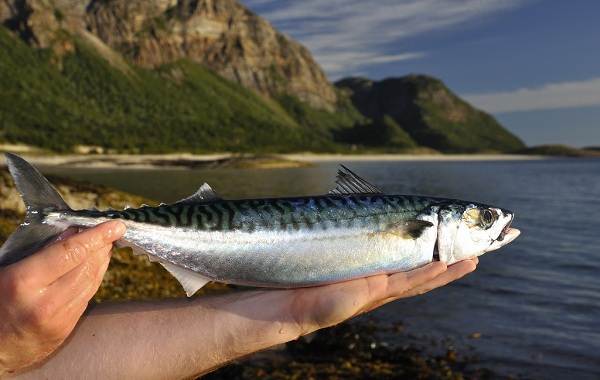
The color of mackerel can hardly be confused with any other: the greenish-yellow or golden belly and the back with a bluish tint, decorated with a wave-like pattern, make the fish recognizable.
Confusion in the mackerel family
Mackerel, like mackerel itself, belong to the mackerel family of the same name. Due to the fact that English-speaking consumers call mackerel, which is familiar to the Slavs, mackerel, recognition difficulties arise when importing.
The sizes of representatives of this family vary greatly in length, sometimes reaching a record several meters. But, regardless of the specific species, they are still predators. Biologists claim that mackerel are somewhat larger than their “colleagues” with which they are regularly confused. Its description includes an elongated carcass, as well as powerful jaws, where triangular-shaped teeth are located for convenient capture of prey. Its favorite habitat is warm seas where there are rocky coastlines or coral reefs.
Two variants are considered record holders for weight among this species: Spanish and striped. They are often caught not only in the coastal zone of the Indian Ocean, but also in the western districts of the Pacific Ocean. The sailors who go fishing in the Mediterranean Sea are not surprised by it. Striped beauties stand out especially clearly due to the special break in the stripes and light belly. There is also a Japanese subspecies, which, as is clear from the assigned name, prefers Japanese waters, and is also found in the waters of Korea and northern China. Usually her weight does not exceed five kilograms. If you manage to catch a giant, you can count on a body about a meter in length.
Despite the fact that the Royal Spanish version seems to be huge, based on the name, it is actually the most modest in size. Individuals barely reach 60 centimeters. You can catch it near the southern or southeastern part of Asia. The traditional diet of the predator is based on the daily consumption of shellfish and eels. But if it was not possible to catch herring fry or other usual lunch, then especially nimble specimens will simply hunt for all the small fish that are within reach.
But no matter what variety the chef decides to cook, he will be satisfied with the result due to its excellent taste characteristics. If you know how to prepare such an almost delicacy, you should choose the royals. They have white tender meat, which, with minimal heat treatment, will delight you with its high nutrient content.
Fishing
In Russia, mackerel fishing is carried out in the southern part of the Norwegian Sea. In this case, special seines and nets are used. Previously, mackerel was also caught in the waters of the Black Sea, but, unfortunately, more than 35 years ago this type of fish disappeared. Mackerel prefers coastal waters. There is no need to go to the open ocean to find this type of fish, which makes it easily accessible for fishing enthusiasts. The most favorable period for fishing is spring. Mackerel caught in the spring is the least fatty. It contains only 3% fat. If the same fish is caught in the fall, the percentage of fat content will increase to 30%. No matter how paradoxical it may sound, the highest percentage of fat content means that the largest amount of vitamins has been accumulated in the fish.
What is the difference between mackerel and mackerel fish: where do they live and how do they differ?
Mackerel is everyone’s favorite fish, which is valued not only by chefs, but also by fishermen.
Quite often during festivals it is present on our tables in salted or smoked form. At the same time, many sellers pass off mackerel as mackerel and vice versa. This fish can be found in the Atlantic Ocean. Both mackerel and mackerel belong to the mackerel family. They are similar to each other in appearance and size. But in the store you may be asked to choose a carcass of different sizes under the same name.
If the fish carcass is smaller, then you can buy mackerel with confidence. And if the fish is fat and large, then it is mackerel.
This is due to the fact that the supply of this fish in the ocean is too large, so many fishermen prefer mackerel.
Differences between mackerel and mackerel
When importing fish into stores, confusion often occurs. All products that are imported are disguised in English. It is noted that both fish have the same markings. The fish are somewhat similar to each other. In order to distinguish them, you need to know all the features of each of them.
In order to understand the differences, you need to see the mackerel in the photo once. OR study photos of mackerel, for example, in fishing magazines and books. The external features of the fish are as follows.
- Both fish have a silver and green tint.
- They are both the same shape.
- Mackerel has tiger stripes on its back that are clearly spaced.
- Mackerel has stripes and dark spots.
- Fishing occurs only between April and October by fishing boats.
Why is mackerel fishing interesting?
Mackerel and mackerel are fatty fish, which are rich and saturated with various omega acids. They are important for maintaining human health. It is actively used for food, but in terms of taste characteristics it is inferior to its relative. Mackerel meat can be tough and dry when cooked.
When cut, mackerel has soft pink meat. In turn, mackerel has a gray tint to its meat. Cutting fish is quite simple. There is no need to remove the scales to cut the fish.
The fish fillet is easily separated from the ridge and can be cleaned with a regular knife, if there are no small bones in it.
Basically, the fish is grilled, baked in lemon juice or brushed with olive oil.
Mackerel and mackerel fish: differences
Residents of English-speaking countries quite often confuse mackerel with mackerel. Fishes of the mackerel family are somewhat similar to each other. But they often differ in size. These can be fish from sixty centimeters to a meter , and sometimes more.
Any fish of this family belongs to predatory fish. Mackerel is larger in size, unlike real mackerel, has an elongated body and powerful jaws; the fish have large triangular teeth.
Moreover, the fish is common in warm seas and near rocky coasts and coral reefs.
Striped or Spanish mackerel is a large representative of this species. It lives in the Indian Ocean and the western Pacific Ocean. The color of the striped fish is distinguished by broken stripes and a light belly. Mackerel is quite common in Asian countries. In this habitat it can reach one meter in length.
In the southeastern part, the mackerel is slightly smaller and reaches no more than sixty centimeters in length. Mackerel fish are classified as predators. It lives in natural conditions and feeds exclusively on mollusks and eels.
Royal fish has dense and white meat and also has beneficial properties and good taste.
How to choose mackerel correctly?
You should choose mackerel fish only if there are clear, transparent eyes and pink gills. Pressing on the fish should not leave any dents. Fresh fish has a faint and sweet odor. This variety does not have a strong fishy odor. It should look moist and shiny, and traces of blood and stains on the carcass are also unacceptable.
In which countries is mackerel preferred?
In our country, mackerel is rarely sold. Basically, if they do this, it is under the guise of mackerel.
And in many other countries, especially in central Europe, it is preferred as a main dish. For example, in England they fry it. In France it is baked in foil.
In the eastern part it is fried a little. In some countries, it is even eaten raw and seasoned with green horseradish or soy sauce.
People associate mackerel with the open ocean, while mackerel is more often remembered smoked or frozen. In any case, these are different fish, although from the same family, both mackerel and mokrel. Their closest relatives are tuna and bonito. Despite the distinctive external differences in appearance, they have many similarities and the main thing is their family.
The family turns out to be huge, and it includes fifty-one fish. Moreover, each of them has its own importance. It is worth noting that mackerels are fast swimmers. For consideration and preparation, three groups of fish from this wonderful family are distinguished.
- Small in size (up to one meter in length).
- Medium size (up to three meters in length).
- Large size (from three meters in length).
Mackerel is a schooling fish that has a spindle-shaped body and a thin and strong tail with a powerful crescent-shaped tail. Rarely can it grow to sixty centimeters.
It is characterized by large numbers and plays a major role in ocean fisheries. It feeds exclusively on small fish. The lifespan of mackerel is no more than eighteen years.
It lives at average temperatures and makes long-distance migrations.
Today, two types of mackerel can be distinguished: Atlantic or Australian.
- Atlantic fish live in the Mediterranean Sea. It can be found off the coast of Europe and on islands. Quite often it lives in Israel, where it is called mackerel.
- The spotted mackerel or Australian mackerel lives on the Pacific coast in Australia and New Zealand. Its weight can reach up to three and a half kilograms. It is worth noting that the catch of this fish is one of the largest.
There are other species, for example, Japanese mackerel. Regardless of its habitat, it comes to us only in frozen form. The largest fish is the Atlantic. Her weight reaches three and a half kilograms. The Australian one can weigh up to one kilogram. And the Japanese fish is about three kilograms.
Fish caught in the spring has a fat content of 3%. In autumn, fish reaches up to 30% fat content. The fattest mackerel is an excellent source of fatty acids and vitamins. Its use is necessary for the human body. It is worth noting that it is recommended to cook mackerel only by baking or grilling over coals.
Both fish have a high percentage of fat content, but despite this they contain a high percentage of vitamins and microelements. Therefore, cooking or frying this product can spoil all the beneficial microelements necessary for the body.
It is recommended to cook fish by baking it over a fire or in the oven. Regardless of whether you choose mackerel or mackerel, both fish will benefit you!
Source: https://zveri.guru/ryby-i-drugie-vodnye-obitateli/ryba-makrel-i-skumbriya-gde-obitayut-i-chem-otlichayutsya.html
